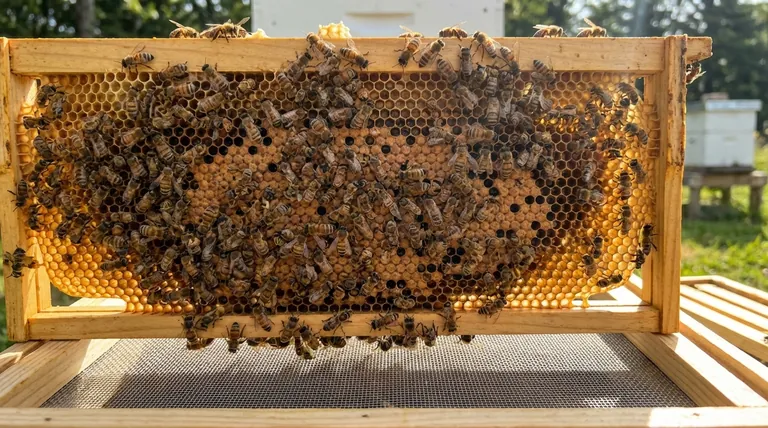The primary benefit of smaller cell sizes in foundationless beekeeping is the potential disruption of the Varroa mite's reproductive cycle. By allowing bees to build their own comb, they often create smaller cells, which in turn produce slightly smaller bees with a shorter development time, giving the mites less time to reproduce within the capped cell.
While the theory of using smaller cells to combat Varroa mites is compelling, it is crucial to understand that it is not a standalone solution. It is one potential component of a broader Integrated Pest Management (IPM) strategy, not a replacement for active mite monitoring and management.

The "Small Cell" Theory Explained
To understand the benefits, we must first look at the mechanism. The argument for smaller cells is a chain of interconnected effects that begins with giving bees control over their own hive architecture.
Natural Comb vs. Standard Foundation
Foundationless beekeeping is a practice where beekeepers provide empty frames, allowing bees to build comb naturally without the guide of a pre-stamped wax or plastic sheet.
Commercially produced foundation typically imprints a cell size of around 5.4 mm. When left to their own devices, many bee colonies will build smaller cells, often in the 4.9 mm to 5.1 mm range.
From Cell Size to Bee Size
A bee's adult size is determined by the size of the cell in which it develops as a larva. Therefore, smaller cells naturally lead to the development of slightly smaller bees.
The Impact on Varroa Mite Reproduction
This is the core of the proposed benefit. The Varroa mite's entire reproductive cycle takes place inside a capped brood cell.
A shorter pupation period for the bee directly impacts the mite. The reduced time from capping to emergence means the founding Varroa mite has less time to lay eggs and for her offspring to mature into reproductive adults. This can result in fewer viable, mated female mites emerging from the cell, thus slowing the overall growth of the mite population in the hive.
Understanding the Trade-offs and Realities
Adopting foundationless beekeeping for its potential mite-related benefits comes with significant practical considerations. It introduces a new set of management challenges that every beekeeper must be prepared for.
It Is Not a Mite-Free Guarantee
It is critical to be clear: simply letting your bees build smaller cells will not eliminate a Varroa mite problem.
At best, it is a factor that may help lower the rate of mite population growth. Hives can and will still be overwhelmed by Varroa if the beekeeper does not monitor mite levels and intervene when necessary.
The Major Drawback: Cross-Comb
The single biggest challenge in foundationless beekeeping is cross-comb. This occurs when bees build their comb not within the confines of a single frame, but across multiple frames.
Cross-comb makes hive inspections nearly impossible without destroying comb, brood, and honey stores. For a new beekeeper, it can be an intimidating and hive-destroying problem.
The Need for Careful Management
To be successful, foundationless beekeeping requires more diligent management. This includes using frames with strong comb guides (like a strip of wood or a line of wax) to encourage bees to build straight. It also requires keeping the hive perfectly level.
Making the Right Choice for Your Apiary
Deciding whether to pursue smaller cell sizes through foundationless beekeeping depends entirely on your goals and management style.
- If your primary focus is reliable Varroa mite control: View small cell theory as a minor, passive aid, not a primary treatment. Your focus should remain on regular mite monitoring and using proven treatment methods.
- If your primary focus is "natural" beekeeping and you are an experienced beekeeper: Foundationless beekeeping can be a rewarding way to work with the bees' natural tendencies and may contribute to long-term hive health.
- If you are a new beekeeper: It is often wise to start with foundation to master the basics of hive inspection before taking on the significant challenge of managing foundationless frames.
Ultimately, allowing bees to build their own comb is an excellent way to understand their biology, but it must be integrated into a realistic and active hive management plan.
Summary Table:
| Benefit/Drawback | Key Takeaway |
|---|---|
| Primary Benefit | May disrupt Varroa mite reproduction by shortening bee development time. |
| Key Reality | Not a standalone mite solution; requires active Integrated Pest Management (IPM). |
| Major Drawback | Risk of cross-comb, making hive inspections difficult without proper management. |
| Best For | Experienced beekeepers focused on natural methods and willing to manage challenges. |
Ready to strengthen your apiary's health with the right equipment?
At HONESTBEE, we supply commercial apiaries and beekeeping equipment distributors with the durable, reliable supplies needed to implement any management strategy—from foundationless frames with strong comb guides to traditional foundation. Let us help you build a more resilient operation.
Contact our wholesale experts today to discuss your apiary's specific needs.
Visual Guide

Related Products
- Langstroth Screen Bottom Board for Beekeeping Wholesale
- Wooden Bee Hive Frames for Beekeeping and Wholesale
- Professional Replacement Bee Smoker Bellows for Beekeeping Equipment
- Mesh Ventilated 3 Layer Goatskin Beekeepers Gloves for Beekeeping
- Professional Galvanized Hive Strap with Secure Locking Buckle for Beekeeping
People Also Ask
- What is the primary function of a screened bottom board in a hive? Enhance Ventilation & Control Varroa Mites
- What are the benefits of using a screened bottom board in warm or humid climates? Boost Hive Health & Control Pests
- What are the benefits of using a screened bottom board for beehives? Improve Ventilation & Mite Control
- What are the advantages of a screened bottom board? Boost Hive Health with Superior Ventilation & Pest Control
- What are some considerations when choosing between solid and screened bottom boards? Optimize Hive Health & Pest Control



















